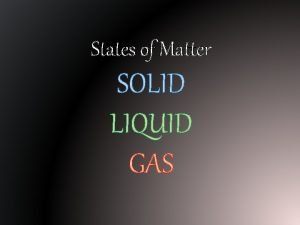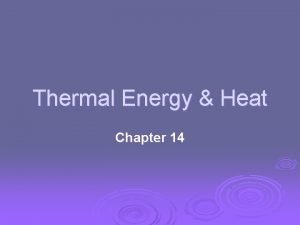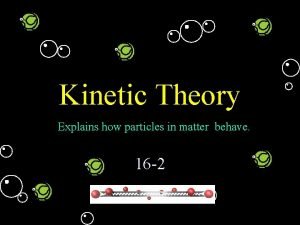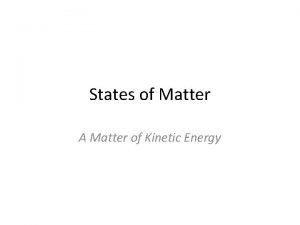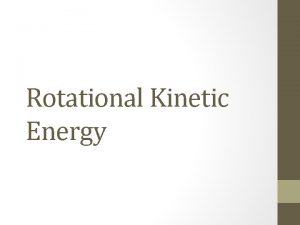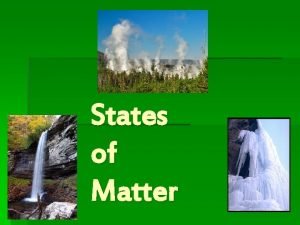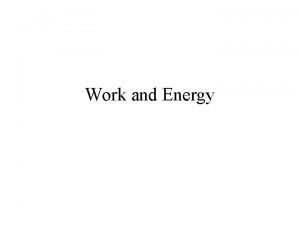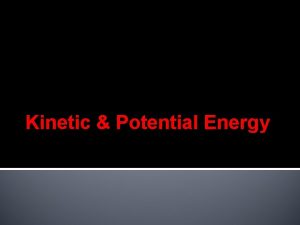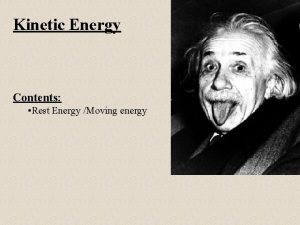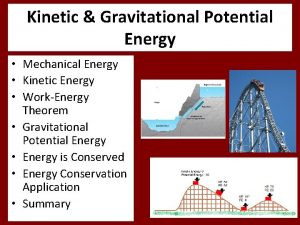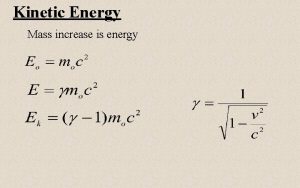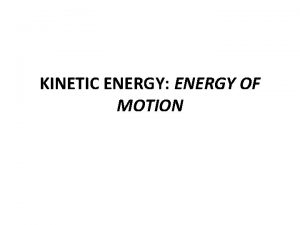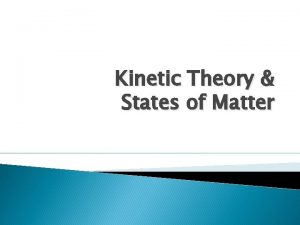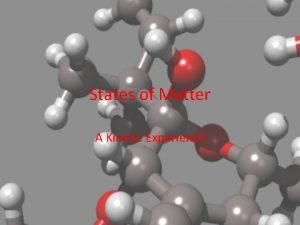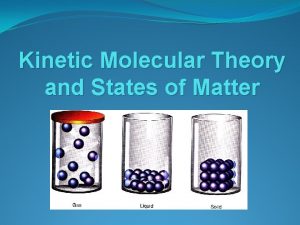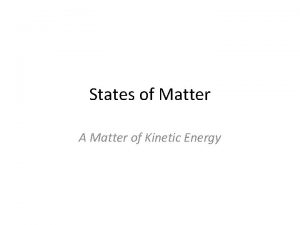States of Matter A Matter of Kinetic Energy





















- Slides: 21

States of Matter A Matter of Kinetic Energy

Types of States of Matter • • • Solid Liquid Gas Plasma Beam BEC, or Bose-Einstein Condensate – Zero State of Matter – Most Dense

Changes of State

Kinetic Energy (kelvins & paschals)

chemwiki. ucdavis. edu/Physical_Chemistry/Physical_Properties_ of_Matter/Supercritical_Fluids • Supercritical fluids are useful in science today – extraction of floral fragrance – the process of creating decaffeinated coffee – food science and functional food ingredients – pharmaceuticals, cosmetics, polymers, powders, bio- and functional materials – nano-systems, natural products, biotechnology, fossil & biofuels, microelectronics & environment (Bottini 133).

www. engineeringtoolbox. com/vapor-steam-d_609 • Superheated Vapor • When the temperature is higher than the boiling point @ a given pressure. • Vapor cannot exist in contact with the fluid, nor contain fluid particles. • Increase in pressure or decrease in temperature will not, within limits, condensate out liquid particles in the vapor. • Highly superheated vapors are gases that approximately follow the general gas law.

Critical Temp & Pressure • Critical Temperature – The temperature at which only gas exists, regardless of its pressure • Critical Pressure – The lowest pressure at which liquids exist at critical temperature • Critical Point – The intersection of critical temperature & pressure

Kinetic-Molecular Theory of Gases • Ideal gas = hypothetical gas perfectly aligns with all kinetic-molecular theory assumptions • Five Assumptions – Distance between molecules dwarfs actual size – All collisions are perfectly elastic – Particles are in continuous, rapid, random motion – Particles have NO attraction to each other – Temperature = average kinetic energy of particles

Nature of Gases • Ideal vs. Real – Real approaches ideal @ low pressure/ high temp • • • Expansion – molecules fill entire space Fluidity – no intermolecular attractions Density - ~ 10 -3 of liquid or solid state Compressibility – 100 X more molecules Diffusion & Effusion – Spontaneous mixing via random motion – Passing through tiny opening

C/C Intermolecular Forces

Properties of Liquids • • LEAST common state of matter in universe Fluids (as are gases) Lower kinetic energy than gases Interactive forces keep molecules connected – Dipole-dipole forces • Equal but opposite charges separated by short distance – London dispersion forces • Spontaneous creation of dipoles (polar & nonpolar) – Hydrogen bonding (electronegativity)

Hydrogen Bonding

Properties of Liquids, continued Density: 100 x > gases; 10% < solids Compressibility: @ 103 atm. , volume ~ 4% Diffusion: present, but slower than in gases Surface tension: high intermolecular attraction Capillary action: attraction between surfaces of liquid and a solid • Vaporization: evaporation & boiling gas • • •

Nature of Solids • Interparticle attractions stronger than others • Two types of solids – Crystalline (orderly arrangement) – Amorphous (random arrangement) • supercooled liquids: have liquid properties even if look solid • • Shape & Volume: Definite Melting Point: Definite Density & Incompressibility: High Diffusion: Low rate (10 -6 less than others)

Dipole-dipole Forces

Covalent Molecular Structures Buckminsterfullerene Glucose – C 6 H 12 O 6

Crystalline Solids • Ionic • Alkali & alkaline earth with halogens & Group 16 • Hard, brittle, high melting points, good insulators • Covalent network • Cx (diamonds), (Si. O 2)x quartz, (Si. C)x • Very hard and brittle, high MP, semi- or nonconductors • Covalent molecular (nonpolar & polar) • H 2, CH 4, C 6 H 6: only weak London dispersion forces • H 2 O & NH 3, : stronger forces but weaker than covalent • Soft, low MP, low BP, good insulators

Crystalline Structures Ag. Cl Ionic Structure

Covalent Network Crystals Diamond Quartz

Covalent Network Carbon Graphite

Covalent Molecular
 The kinetic theory of matter states that
The kinetic theory of matter states that Potential energy of a spring
Potential energy of a spring Mechanical energy pics
Mechanical energy pics Gravitational potential energy vs kinetic energy
Gravitational potential energy vs kinetic energy Kinetic energy to thermal energy
Kinetic energy to thermal energy The law of conservation of energy states that
The law of conservation of energy states that Kinetic energy
Kinetic energy Mechanical energy conservation
Mechanical energy conservation Gravitational potential energy
Gravitational potential energy Conservation of mechanical energy
Conservation of mechanical energy States of matter thermal energy
States of matter thermal energy Thermal energy vs heat
Thermal energy vs heat Thermal energy in states of matter
Thermal energy in states of matter Ecological succession
Ecological succession Kinetic theory of matter definition
Kinetic theory of matter definition Kinetic theory of matter
Kinetic theory of matter The kinetic theory explains how particles in matter behave
The kinetic theory explains how particles in matter behave Kinetic particle theory of matter
Kinetic particle theory of matter What is a kinetic theory of matter
What is a kinetic theory of matter There were 11
There were 11 Map of northern united states
Map of northern united states Checks and balances dbq
Checks and balances dbq










